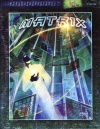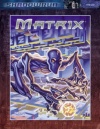Quelle, en: Matrix: Unterschied zwischen den Versionen
Kathe (Diskussion | Beiträge) KKeine Bearbeitungszusammenfassung |
(+Verlinkung mit Vorlage:Impressum) |
||
| Zeile 19: | Zeile 19: | ||
|ISBN10=155560-401-3 | |ISBN10=155560-401-3 | ||
|CREDITS= | |CREDITS= | ||
*''Autoren:'' Rob Boyle, Michael Mulvihill, Randall Bills, Drew Curtis, Dan Marcucci, Kenneth Peters, John Schmidt, Darcie Stratton, Jon Szeto, Rich Thomasso, Malik Toms, Frank Werschke& Jakko Westerbeke, Sebastian Wiers | *''Autoren:'' {{Impressum|Rob Boyle}}, {{Impressum|Michael Mulvihill}}, {{Impressum|Randall Bills}}, {{Impressum|Drew Curtis}}, {{Impressum|Dan Marcucci}}, {{Impressum|Kenneth Peters}}, {{Impressum|John Schmidt}}, {{Impressum|Darcie Stratton}}, {{Impressum|Jon Szeto}}, Rich Thomasso, {{Impressum|Malik Toms}}, {{Impressum|Frank Werschke}}& {{Impressum|Jakko Westerbeke}}, {{Impressum|Sebastian Wiers}} | ||
*''Cover-Artwork:'' Fred Hooper / Jim Nelson (Alternativ-Cover) | *''Cover-Artwork:'' {{Impressum|Fred Hooper}} / {{Impressum|Jim Nelson}} (Alternativ-Cover) | ||
}} | }} | ||
''Reality is for those who lack imagination'' | ''Reality is for those who lack imagination'' | ||
Version vom 22. Mai 2011, 10:40 Uhr
| Informationen | ||||
|
| ||||
| Verlag: FASA (eBook-Ausgabe: Catalyst Game Labs) | ||||
| Nummer: 7909 | ||||
| Edition: 3 | ||||
| Sprache: englisch | ||||
Übersetzung:
| ||||
| Format: Softcover (auch als eBook wiederveröffentlicht) | ||||
| Seitenanzahl: 176 | ||||
Preis:
| ||||
| ISBN: | ||||
Credits:
| ||||
Reality is for those who lack imagination
Connect to the world-wide net known as the Matrix and create a universe of your own. No matter what your status in the real world--megacorp president or synthmeat street vendor--you can be the lord of all you can imagine. Access virtual clubs and test your skills in total-reality games. Ransack massive databases and pillage corporate systems for paydata--and try to stay alive long enough to enjoy the results.
Matrix expands on the basic decking rules provided in Shadowrun, Third Edition, and offers advanced rules for programming, deck construction, system security and accessing the Matrix. Matrix includes rules for information searches and new updates on artificial intelligences and otaku characters.
Inhaltsverzeichnis
- INTRODUCION
- THE MATRIX WORLD
- Communication
- Life at the Speed of Light
- Please Leave a Message at the Beep
- The Wired Life
- Business and the Matrix
- The Bottom Line
- Investing in the Sixth World
- Electronic Funds
- Have Cred, Will Travel
- Beyond the Information Age
- Relevance of an Information-Saturated Society
- Searching for Data
- Personal Data and Privacy
- Matrix Culture
- Culture Shock in 3-D
- Sprawl Management
- The Necessities of Life
- Matrix Law
- The Law of the Land
- Communication
- THE COMPUTER INTERFACE
- THE MATRIX USER
- Attributes
- Reaction and Initiative
- Skills
- Active Skills
- System Familiarity Knowledge Skills
- Program Design Knowledge Skills
- Cyberterminal Design Knowledge Skill
- Info Sortilage Knowledge Skill
- Other Knowledge Skills
- Dice Pools
- Hacking Pool
- Edges and Flaws
- Matrix Addiction Flaw
- Matrix Users in Game Play
- Optional Rule: SOTA
- SOTA Factor
- Lifestyle and SOTA
- Maintenance Costs
- Attributes
- ACCESSING THE MATRIX
- The Jackpoint
- Jackpoint Values
- Hardwired Jackpoints
- Wireless Links
- Wireless Link Values
- Signal Strength
- Wireless Link Types
- Daisy-Chained Wireless Links
- Matrix Services
- Services and Costs
- Boosting Matrix Services
- MSP Accounts
- Registering an MSP Account
- Passcodes
- Account Privileges
- Billing
- The Datatrail
- Decking and Unauthorized Access
- Access through Deception
- Spoofing Jackpoints
- Using a Throwaway MSP Account
- Passcode Security
- Visibility and Perception
- Behind the Scenes
- System Iconography
- Matrix Movement
- Tortoise Mode
- Tortoise Operations
- The Jackpoint
- GRIDS AND HOSTS
- Connections
- Wirecom
- Wavecom
- Beamcom
- Satcom
- Regional Telecommunications Grids (RTG)
- Iconography
- RTG Politics
- Satellite Constellation RTGs
- Local Telecommunications Grids (LTG)
- Iconography
- Private Local Telecommunication Grids (PLTG)
- Iconography
- How Hosts Work
- Ultraviolet Hosts
- Connecting to a UV Host
- More Real Than Real
- Back to Reality
- Paydata
- Nature of the Data
- Random Paydata Generation
- Paydata Defenses
- Fencing Paydata
- Archaic Systems
- Limitations
- Connections
- CYBERTERMINAL CONSTRUCTION
- Components
- Tools and Parts
- Construction Tests
- Skills
- Time
- Health and Tasks
- Design Tests
- Software Tests
- Cook Tests
- Installation Tests
- Requirements
- Constructing Components
- Active Memory
- ASIST Interface
- Hardening
- ICCM Biofeedback Filter
- Icon Chip
- I/O Speed
- Maser Interface
- Matrix Interface
- MPCP
- Persona Chips
- Ports (FUPs)
- RAS Override
- Reality Filters
- Response Increase
- Signal Amplifier
- Storage Memory
- Wireless Interfaces
- Miscellaneous Components
- Partial Construction
- Hardwiring
- Salvaging
- Mismatched Components
- Cranial Cyberterminals (C2)
- C2 Parts
- Cyberlimb Cyberterminals
- Custom Designed Cyberterminals
- Choosing the Options
- Calculating the Cost
- Shop Installation
- UTILITIES
- New Utilities
- Operational Utilities
- Camo
- Crash
- Defuse
- Doorstop
- Encrypt
- Evaluate
- Mirrors
- Purge
- Redecorate
- Sniffer
- Snooper
- Swerve
- Triangulation
- Validate
- Special Utilities
- BattleTac Matrixlink
- Cellular Link
- Compressor
- Guardian
- Laser Link
- Maser Link
- Microwave Link
- Radio Link
- Remote Control
- Satellite Link
- Offensive Utilities 73
- Erosion
- Hog
- Steamroller
- Defensive Utilities
- Restore
- Shield
- Operational Utilities
- Advanced Uses for SR3 Utilities
- Operational Utilities
- Special Utilities
- Offensive Utilities
- Defensive Utilities
- New Utilities
- PROGRAMMING
- The Programming Test
- Program Ratings
- Program Size
- Base Programming Time
- The Program Plan
- Programming Tools
- The Computer Test
- The Task Period
- Programming Teams
- The Finished Code
- Upgrading
- Optional Rule: Bugs
- Program Options
- Options and Size
- Options and Ratings
- Options and Cost
- Utility Options
- IC Options
- Programming Suite Options
- Command Sets
- Making a Command Set
- Activating a Command Set
- Command Set Operations
- Shutting Down Command Sets
- Frames and Agents
- Frame Core
- Designing Frames and Agents
- Loading Utilities
- Running a Frame or Agent
- Dumb Frame Rules
- Smart Frame and Agent Rules
- IC Constructs
- Construct Cores
- Operating Constructs
- Worms
- The Bait
- Infection
- Prevention
- Infected Cyberterminals
- Types of Worms
- Buying Programs
- Verifying Software Contents
- Applications
- Multipliers
- Ratings
- The Programming Test
- SYSTEM OPERATIONS
- New Operations Descriptions
- Abort Host Shutdown
- Alter Icon
- Analyze Operation
- Block System Operation
- Crash Application
- Crash Host
- Decoy
- Disarm Data Bomb
- Disinfect
- Dump Log
- Encrypt Access
- Encrypt File
- Encrypt Slave
- Freeze Vanishing SAN
- Infect
- Intercept Data
- Invalidate Account
- Locate Frame
- Locate Paydata
- Locate Tortoise Users
- Redirect Datatrail
- Relocate Trace
- Restrict Icon
- Scan Icon
- Send Data
- Trace MXP Address
- Triangulate
- Validate Account
- Advanced SR3 Operations Descriptions
- Making Operations for Other Users
- New Operations Descriptions
- INTRUSION COUNTERMEASURES
- New Intrusion Countermeasures
- Data Bomb White IC
- Pavlov White IC
- Scout White IC
- Trace IC
- Cerebropathic Black IC
- Psychotropic Black IC
- Advanced Uses for SR3 IC
- Programming IC
- Crashing IC
- New Intrusion Countermeasures
- MATRIX SECURITY
- Advanced Security
- Security Tallies and Multiple Icons
- Host Shutdown
- Optional Rule: Varying Subsystem Ratings
- Generating Security Sheaves
- Creating Constructs
- Additional Security Features
- Security Deckers
- Caveats
- Sheaves on the Fly
- Grid Security
- Alerts
- Security Deckers
- Grid Shutdown
- Security Tally Carry-over
- Advanced Security
- INFORMATION SEARCHES
- Using Etiquette (Matrix)
- Matrix Social Situations
- Matrix Contacts
- Using Computer Skill
- Search Areas
- Types of Info Searches
- The Search Test
- Sample Databases
- Using Etiquette (Matrix)
- THE OTAKU
- The Reality
- Using Otaku
- Becoming Otaku
- Tribal Initiation
- The Deep Resonance 134
- The Paths
- Submersion
- AI-Created Otaku
- Creating an Otaku Character
- Using the Priority System
- Using the Point System
- Allocating Attributes
- Allocating Skills
- Allocating Resources and Lifestyle
- Allocating Complex Forms
- Designing the Living Persona
- Dice Pools
- Choose a Path
- Otaku Rules
- Detection Factor
- System Attunement
- Using the Living Persona
- Living Persona and Cybercombat Damage
- Improving the Living Persona
- Otaku and the SOTA
- Otaku and Jackpoints
- Using Channels
- Channel Immunity
- Complex Forms
- Options
- Creating Complex Forms
- Using Complex Forms
- Sprites
- Creating Sprites
- Using Sprites
- Otaku Tribes
- Resonance Wells
- Tribal Resources
- Joining a Tribe
- Founding a Tribe
- Tribe Generation
- Submersion
- Grades
- Cost of Submersion
- Echoes
- Improved I/O Speed
- Improved Hardening
- Improved MPCP
- Improved Persona
- Improved Reaction
- Daemon Summoning
- Ghosting
- Info Sortilage
- Neurofilter
- Overclock
- Resonance Link
- Switch
- Traceroute
- The Fading
- The Reality
- AUTONOMOUS PROGRAMMS
- Semi-Autonomous Knowbots
- True Artificial Intelligence
- MATRIX PLAYERS
- The Providers
- Playing with Toys
- Code Kings
- Information is Power
- Other Powers that be
- Observers and other Nosy Bastards
- Credit where Credit is Due
- The Virtual Underground
- I Hack, Therefore I Am
- MATRIX TABLES
- Sample RTGs from Around the World
- System Operations
- Utilities
- Programm Size Table
- Programming Tables
- Intrusion Countermeasures
- Worm
- Cyberdeck
- Component
- Jackpoint and Wireless Link
- Search Test
- Matrix Data Sheet
- Otaku Record Sheet
- Frames & Agents Record Sheet
- Sprites & Deamons Record Sheet
- IC Construct Record Sheet

